Book contents
- Frontmatter
- Contents
- List of figures
- List of tables
- Glossary and note on orthography
- Preface
- 1 Introduction
- 2 Historical perspectives
- 3 Huli society
- 4 Ideas of health and illness
- 5 Morbidity, explanations and actions: quantitative perspectives
- 6 Illness attributed to proximate causes
- 7 Explanations relating to sexuality and growth
- 8 Illness grounded in social relations
- 9 Spirits and God
- 10 Patterns of response
- References
- Index
- Cambridge Studies in Social Anthropology
6 - Illness attributed to proximate causes
Published online by Cambridge University Press: 14 September 2009
- Frontmatter
- Contents
- List of figures
- List of tables
- Glossary and note on orthography
- Preface
- 1 Introduction
- 2 Historical perspectives
- 3 Huli society
- 4 Ideas of health and illness
- 5 Morbidity, explanations and actions: quantitative perspectives
- 6 Illness attributed to proximate causes
- 7 Explanations relating to sexuality and growth
- 8 Illness grounded in social relations
- 9 Spirits and God
- 10 Patterns of response
- References
- Index
- Cambridge Studies in Social Anthropology
Summary
In this chapter I consider Huli diagnoses that are primarily descriptive, and those which refer to processes of physiology and pathology as these are understood by them. Diagnoses of this sort account for the vast majority of instances of illness. On the relatively uncommon occasions when they explain their ills according to the particular circumstances that led to the development of the illness, the process is also likely to be describable in terms of the bodily changes produced by the prior cause. I will begin by describing their broad view of bodily and psychological processes.
The Huli have a good anatomical knowledge and an extensive vocabulary relating to parts of the body. As we would expect, the focus of this knowledge relates directly to their concerns. Bodily appearance is highly significant to them, and their language possesses a large number of terms which allow them to discriminate finely between different areas of the skin and even different areas of the hair. Knowledge of internal anatomy is now applied only in the dissection of pigs, but formerly was necessary for surgery and post-mortems.
In general, they are not concerned to ascribe specific bodily functions to particular anatomical organs. The liver (buni) and lung (gubalini) may be said to house the bu (life force). But it is the roving bu that is of more interest, not the static tissues through which it may pass.
- Type
- Chapter
- Information
- The Huli Response to Illness , pp. 81 - 96Publisher: Cambridge University PressPrint publication year: 1986



